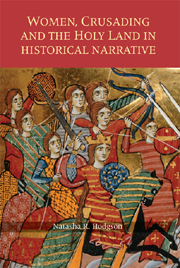General Editor's Preface
Published online by Cambridge University Press: 12 September 2012
Summary
Crusading, like other kinds of warfare, might seem a ‘boy's game’, fit for play only between consenting males from a warrior culture. The role for a woman, at best, was surely restricted to shouting encouragement from the sidelines, much as they did at contemporary tournaments. While it is true that, in all but a tiny minority of cases, women did not get involved in actual fighting, save perhaps as victims, there were many opportunities for certain female individuals to influence events in ways not previously much considered by historians. In part this was because crusading was an activity engaged in by Latin Christian societies as a whole; so that young and old, male and female, secular and celibate, could all fulfil useful roles in the ‘great project’ of the capture and retention of the Holy Land, its associated territories and many lands far distant from the original destination of Jerusalem.
What Dr Hodgson makes clear in this volume is that women played a crucial role in the propagation of crusader ideas and in their practical support through the provision of finance and often direct military aid to operations. In the Kingdom of Jerusalem itself, from 1186–1228 (effectively covering the period of the loss of the city until its recovery by Emperor Frederick II) four queens dominated the politics of the time. It was inevitable that rulers and aristocratic women in general would play the greatest part in directing activities concerning crusading, although some of lesser rank could also be influential.
- Type
- Chapter
- Information
- Women, Crusading and the Holy Land in Historical Narrative , pp. vii - viiiPublisher: Boydell & BrewerPrint publication year: 2007



